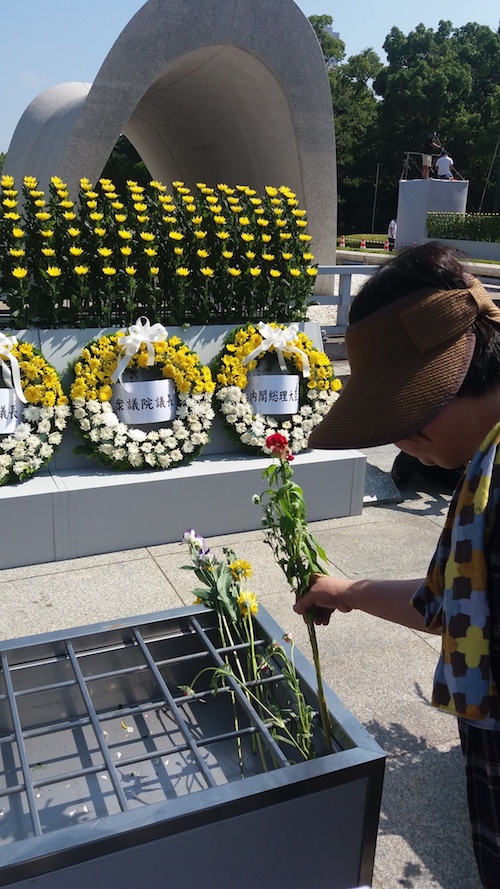Hiroshima, August 6th 2018

73 years after the bomb fell, I attended the Hiroshima memorial ceremony event on August 6th, 2018.
Thousands of Japanese and foreigners gather in the peace park "to console the souls of the victims, and to pray for peace". Hundreds of volunteers guide them along - scouts and children handing out flowers and programmes, crane origami papers and instructions, men and women holding ropes and signs for crowd guidance. A warm and sunny summer day in southern Japan also requires volunteers handing out cups of free cold water and (very welcome indeed!) small rolls of white, wet, frozen cloths for cooling. Of course queuing and standing must be expected. The crowds endured the heat and the evocations of the terrible event by the speakers with solemn patience, all uncovering their heads praying with eyes closed at 8:15.
Being an obvious foreigner, I was also given an invitation to an event where hibakusha - survivors - would share stories in English. Of course the still living survivors were rather young - one of them just an unborn child - all those years ago. Yet three people shared both family- and personal memories. One of them even told us she did so for the very first time.
I have never before really understood what a hard work it is to keep the stories of August 6th 1945 alive. Re-telling those traumas is of course a heavy emotional labour for the hibakusha themselves. I believe it also takes its toll on everyone. Even though the city and the people of Hiroshima have turned the past into a beautiful and precisely choreographed ceremony, it’s still a choice to keep evoking those memories. Choosing to show the world those invisible and painful scars - year after year. Current school- and university students also shoulder some of this work by listening to the hibakusha and attempting to capture and transmit their memories in art, theatre and animation.
What, then, has been the significance of this continuous effort?
During those 73 years, the world has not exactly been a peaceful place. We’ve had cold wars and hot wars, and we’ve been shockingly close to real atomic wars breaking out - either due to political tensions like the Cuban missile crisis, or even due to errors, misunderstandings, and testing gone dangerously wrong. At times of extreme risk, leaders have luckily shown restraint and made the right decisions - so far..
All considered, I believe we owe the hibakusha of Hiroshima and Nagasaki more than we can possibly imagine. If they had hid their scars, stayed silent and moved on with their lives - we would all have a much poorer impression of the impact of a nuclear war. Without that impression, would our leaders have shown the same restraint? I believe not. I do believe the survivors of Hiroshima have already saved humanity from annihilation several times, through their brave testimonials and peace campaigns.
I do have a wish though. There have been many wars - thankfully not with nuclear hellscapes, but nevertheless wars that scarred and traumatised a lot of people during those years. What if the hibakusha of Hiroshima decided to teach the world yet another lession by inviting other war-survivors to pick up the torch of peace? What an amazing power it would have to see a hibakusha share a stage and a story with a survivor from Pearl Harbour! Or a survivor from Nanking, or the Korean and Vietnam wars! Hiroshima - with its special place in the world’s consciousness - could be a place where former enemies could share their insights into their own pain and history. Call it something like the "Hiroshima global scars initiative".
Maybe this sort of work has been done already. If so, pardon my ignorance. And thank you, hibakusha and the people of Hiroshima, for the work you’ve already done for humanity and the planet. I promise to remember what you told me on August 6th 2018.
<<: Frozen song - Zero Visibility 10/25 2017 -- Fairy tale heroines >>
